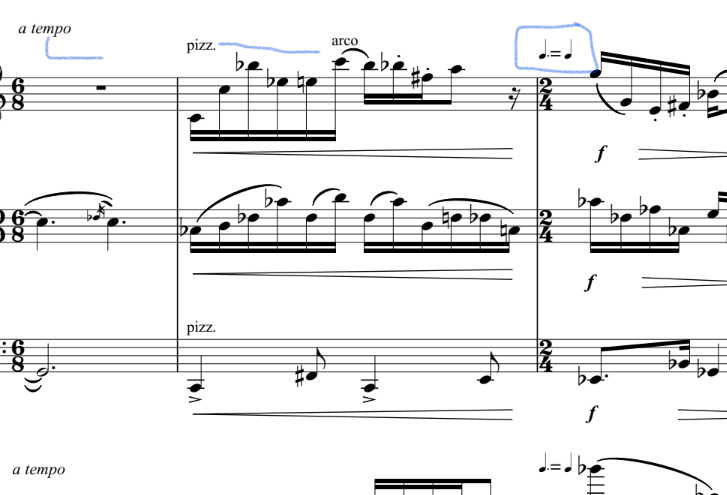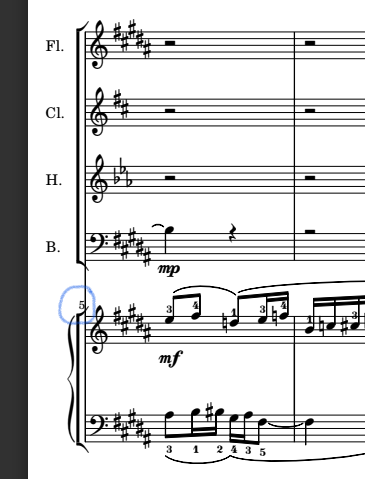Leaderboard
Popular Content
Showing content with the highest reputation since 10/29/2025 in all areas
-
First of all, I have to say that I really enjoyed this competition! It was an intense two weeks—on the one hand, to finish my own composition/arrangement, and on the other hand, to listen to such a diverse range of great musical works. I think all the participants invested a lot of time, effort, and passion to achieve such a result! I must admit that – puh – reviewing seems to be harder than composing! We have seen a lot of atonality and non-traditional musical structure (to mention some, but not to be exhaustive all "Dima’s National Dance" by @Dima, "From Above, Now Below" by @Thatguy v2.0, "Diptych for Piano Quartet" by @Cosmia, "Aos Si" by @HoYin Cheung, "American Cryptids" by @Micah, "Fumage" by @Justin Gruber, "Clowns" by @sebastian Pafundo, "Woodwind Quintet" by @Maxthemusicenthusiast, "The Mist" by @Kvothe, "A Hollow Theme for Halloween" by @therealAJGS) and – on the other hand – more „beautiful“ and „well-behaved“ pieces (for example, "Ghost Town Requiem" by @UncleRed99, "Bagatelle No. 6" by @Omicronrg9 and "Dance from the skeleton ball" by @MK_Piano), which I very enjoyed, too. As „balanced“ between this two poles I would consider "Daunting Steps" by @ferrum.wav, "Trio Variations" by @TristanTheTristan and – lol - my own piece. Therefore, the decision was very hard and due to the subject of the competition, Halloween, the more outlandish pieces were in the better position. The dedications of the badges „spookiest/scariest piece“, „strangest/weirdest/most outlandish piece“ and „biggest thriller“ were – in my opinion – not so easy to distinguish, so that we have one glorious winner in nearly all categories, "From Above, Now Below" by @Thatguy v2.0, my best congratulations. Special thanks to @PeterthePapercomPoser for organizing that funny contest! What did you think of the official competition reviewing template? For me, the competition reviewing template was very useful, giving the focus what to review a clear structure. Even if I did not give a textual review according to the eight categories but only a general one, scoring according to the definitions (i.e. between 0 and 10 points) and calculating an average was useful and helped to determine the winner(s) for the different badges. I could also imagine that in future competitions, the template and the numbers will be used in an official sheet to determine the overall winner. In such a case, however, it would be necessary to formulate more precisely how we should award the points in order to achieve a fair result that can be used for such a calculation. I noticed that some of the reviewers often awarded 10 points to pieces/categories they liked, while I was a bit stingy with this top score (apologies to all participants). I would like to say that such differences in the use of scores between different reviewers, although consistent in their own assessment, could lead to a kind of injustice. What would you like to see in future competitions? I think, the most revenue of the competition is getting a lot of review in a short period of time. Therefore, I would like to keep the competition „just for fun“ without monetary awards. An interesting variant could be to keep the competitors and judges anonymous. Such a rule could be combined with the mandatory use of the template and its usage for the calculation of the winner, as mentioned above. In such a case it would be necessary to require that all participants review all the other entries to achieve comparability and fairness. However, such a strict set of rules could imply that some members would hesitate to participate, thus we could try out that for one competition, but should not apply it to all future ones.6 points
-
Dear readers, This is my submission for the Halloween (Fall 2025) competition. I realize it’s quite a last-minute entry, but after discovering the event a few days ago, I decided to give it a try for fun. I’m genuinely excited that we can all share and experience each other’s music. It’s wonderful to meet you all and hear your work. About this submission: Diptych for piano quartet - I haven’t settled on a title yet, so it will remain Diptych for now - a two-part musical piece, hinged yet paired to form a unified whole. It leans toward the contemporary classical genre, shaped by elements of both expressionism and impressionism. If I had more time (and I hope there will be more competitions like this), I might have written something more whimsical or festival-inspired for the occasion. Still, to me, contemporary harmonies and expressions possess their own kind of "terrifying" beauty that is celebrated on Halloween. My inspirations for this piece include artworks such as Francis Bacon’s Painting 1946 and Francisco Goya’s Saturn Devouring His Son. Kind regards, Cosmia6 points
-
Thanks to all 16 participants who submitted music to the competition - the recipients of the "2025 Halloween Participant" Award: Fumage - Trio for Flute, Oboe, and Bassoon (Halloween Competition Submission) by @Justin Gruber CLOWNS - Fall 2025 Halloween Competition Submission by @sebastian Pafundo Woodwind Quintet No. 1 - Halloween Competition Submission by @Maxthemusicenthusiast Trio Variations in D minor: A Submission to the 2025 Halloween Composition Competition by @TristanTheTristan Aos Si - Piano Quintet for Halloween by @HoYin Cheung YCF Composition Competition - Halloween 2025 (Submission) by @UncleRed99 YC Halloween Contest Entry - The Mist by @Kvothe Bagatelle No.6 | Om. 101 by @Omicronrg9 2025 Halloween Competition - DANCE FROM THE SKELETON BALL (Submission) by @MK_Piano From Above, Now Below by @Thatguy v2.0 A Hollow Theme for Halloween (Fall 2025 Competition) by @therealAJGS Piano Quintet in G sharp minor - 2025 Halloween Competition Submission by @Wieland Handke American Cryptids - Fall 2025 Halloween Submission by @Micah Dima’s National Dance - 2025 Halloween Submission by @Dima Daunting Steps - Quintet for Piano, Flute, Contrabassoon, Violin and Cello - 2025 Halloween Submission by @ferrum.wav Diptych for Piano Quartet (Submission) by @Cosmia The members have voted! --<< Decisive Fanfare >>-- And the winners are: For winning the "2025 Halloween Spookiest Piece" award with 9 votes - "From Above, Now Below" by @Thatguy v2.0 will receive the following badge: For winning the "2025 Halloween Strangest Piece" award with 8 votes - "Aos Si" by @HoYin Cheung will receive the following badge: For winning the "2025 Halloween Biggest Thriller" award there is a tie with 5 votes each! - "From Above, Now Below" by @Thatguy v2.0 and "Diptych for Piano Quartet" by @Cosmia will receive the following badge: For winning the "2025 Halloween Theme Winner" award with 7 votes - "From Above, Now Below" by @Thatguy v2.0 will receive the following badge: Congratulations to all the winners! We will now move your pieces into the "Competition Hall of Fame" subforum! And thanks to all the following participants who also reviewed all the entries! The contest would not have been as much fun and as instructional as it was without you! The following members will receive the "Ardent Reviewer" badge () for their efforts in meticulously reviewing all the entries: @TristanTheTristan, @Kvothe, @Omicronrg9, @Thatguy v2.0, @therealAJGS, @Wieland Handke, @Henry Ng Tsz Kiu, @chopin and myself @PeterthePapercomPoser And thanks to me @PeterthePapercomPoser for organizing and managing all the competition polls, announcements, submission thread, badges, results, satisfaction survey and advertising outreach! I will receive the "2025 Halloween Community Organizer" badge: To take the 2025 Halloween Satisfaction Survey go here: To listen to all the entries go to the submissions thread: To check out the popular voting polls go here: And for the competition announcement go here:5 points
-
I'm glad most people are favoring the fun part of the competition rather than monetary rewards. I think it's best to keep it that way for now, and your divisions would be good to use as the badge rewards instead of what we did. However, since we wanted it to be a poll instead of actual judging this time (it was thrown together pretty quickly), I like the categories we used as easy fun ways to vote. In hindsight, as I voted, I noticed there wasn't any "most fun" category, which yours clearly would have won to me. @PeterthePapercomPoser pointed it out in our discord, and we should've had that category. These are easy ways to improve managed by experience and feedback. With actual judging, your way is the way to move forward imo. More afterthoughts: I like the poll as an alternative to judging, I think both are equally valid. I'm not a fan of seeing who you vote for, but I know I'm in the minority with that. The framework for assigning numbers kind of got out of hand imo, but I'm glad people seemed to have fun with it. It wasn't necessary, but I'm glad it was an aide for people in determining which pieces they liked best. Being up front about WHAT we would be voting for would maybe be better for future poll based competitions.5 points
-
This is just a reminder post for those wishing to receive an "Ardent Reviewer" badge that by Monday 11:59 pm PST you might still need to review some works! @Omicronrg9, @Wieland Handke, @Henry Ng Tsz Kiu, @chopin, and myself @PeterthePapercomPoser have reviewed all the entries (minus their own) and will receive the "Ardent Reviewer" badge! @TristanTheTristan - you still need to review Thatguy's piece and the last five pieces in the list. You will receive the "Ardent Reviewer" badge! @HoYin Cheung - you've only reviewed two pieces. Do you still intend to review the rest? @UncleRed99 - you still need to review Omicronrg9's piece and the last six pieces in the list. @Kvothe - you still need to review Maxthemusicenthusiast's piece and UncleRed99's piece. You will receive the "Ardent Reviewer" badge! @MK_Piano - you still need to review sebastian Pafundo's, Maxthemusicenthusiast's, Kvothe's, Thatguy v2.0's, and the last five pieces. @Thatguy v2.0 - you still need to review Micah's and Dima's pieces. @therealAJGS - you still need to review Maxthemusicenthusiast's, TristanTheTristan's, and the last two pieces. You will receive the "Ardent Reviewer" badge! @Cosmia - you've only reviewed three pieces. Do you still intend to review the rest? Of course, we're all grateful for your time and your willingness to review however much you want to! Thank you for making this competition fun and instructional for everyone!5 points
-
Hey dude Apparently some aren't aware you aren't using notation software. Don't worry about your score, your program isn't designed for that. You're writing music and that's all that counts, and we have ears so we can hear what you're doing. I used to use Cubase to write music, and I submitted a piece for a competition here some years ago and all people did was whine and cry about the score, asking me if it's playable. I tried explaining that I wrote it to be playable, but it was impossible to make the score it creates legible. I didn't win, and I knew I wouldn't, but who cares. I wrote something cool, and I still like it to this day. If you ever want to try musescore or something similar, it's free, and I'm sure if it's not already optimized for mobile, something exists that does or it's soon to be in the future. Those are designed with score creation at the forefront, and if you ever get the hang of it, you might learn about areas in music you otherwise wouldn't. If you decide against it or like what you use now, that's fine too. Most people in the world DON'T use notation software for writing music. This site mainly has people who write with notation software because they're writing for performers, but your music is just as welcome. This had all the Halloween elements, and instrument choice was great! I'm not giving out any scores, but you get one of these: 🎃 I like the chord change at 2:15 or so, it broke up the static harmony really well. Sounds like your in minor, know all the chords you can go to? Try other ones out if you're ever stuck on ideas, might give you new options for your harmony. Your ideas worked really well together, nice job on this! Be sure to vote 😄5 points
-
4 points
-
You're welcome! I enjoyed it! First, thank you for voicing your opinion! When we've done competitions with monetary awards and official judges in the past this was an issue that people have brought up. However, ultimately, when the different scores from the different judges were averaged together, as long as the judges tried to accurately reflect the differences between the various musical entries in their scores then once the scores were all averaged together, even if say, some of the judges scored the pieces in a different range of the scale than others, the scoring still worked to accurately reflect the differences in quality between the different entries. In the past when we had competitions with monetary awards, the entrants were kept anonymous by sending their entries by personal message to me. I would then add their entry to the submissions thread. I think in a free contest, this requirement might be too strict. And I personally don't like the idea of keeping the names of the judges anonymous because it discourages discussion and interaction between the judges and the members. Thanks for voicing your opinion!4 points
-
this is a submission for the 2025 halloween competition. i was just really going for a spooky halloweeny vibe but not like "terror and dread and killer" vibes. it's definitely lighter than the other submitted pieces. also, contrabassoon! very spooky sounding instrument, and i've tried my best to harness that specific quality of it. enjoy! update: -updated score from @Kvothe's feedback4 points
-
Here is my submission. The whole string quintet is 5 movements, but I've just given the first 3 to fit the time slot. It's a link to the Google Drive folder with the WAV files and score. https://drive.google.com/drive/folders/1MD4VU4YyL0m1n5gULbGStdbZU396P_oN?usp=sharing I hope I put this in the right place- I'm quite obtuse when it comes to this website.4 points
-
I know your pain, I think it's rained for a week straight. But Halloween is tonight for me, maybe the dreary cloudy vibe will help the snobbery of my vampire persona Thanks for commenting, glad you liked it! TFW you hear a Henryism for the first time 😄 Hahahahaha! Glad I can keep you on your toes. Thanks for the kind words Mike! Hey thanks for commenting, I'm glad you liked it! Regarding the ledger lines, I agree. How should it be written? I know string players don't always mind ledger lines because of hand positions, but I'm not sure.4 points
-
Hi Ferrum. When I open the PDF window to check it turns out I just cannot. Something's wrong, but not sure if it's in your side or it's the forums, or... Either way I am very curious about the score, duh. This seems to me like a small medley (well maybe not small actually) that contains a wide range of stuff going on but that seems to be permeated by this motif that you don't cease to state and use to transition to all sorts of places. It's like a spring, moving slightly upward and returning, giving birth to new passages endlessly. I must say though that the general feeling this piece gave me was not as concrete as other clear front-runners as you (front-runners to me, obv.). It was enjoyable, anyways! Maybe my shortest review today, but I cannot really find anything to point out about the piece that be worthy of a line or two more, plus I cannot access the score 😞. In summary, I did like some sections more than others, and I didn't feel it very light to be honest! Maybe when put in comparison, you're right. Many thanks for your submission, Ferrum! Kind regards, Daniel–Ø.4 points
-
The instrumentation choice, the mixed quintet, was very clever given you the chance of having so many different combinations and colors with the instruments, so that the excessive occurence of the themes never gets boring or repetitive. I must admit that I have discovered the existence of two clear defined (melodic) subjects only upon second listening (and after reading your form description). Maybe I've listened too many atonal music the last few days. With this in mind I would consider it as a polyphonic piece – not a classical fugue – but a combination of counterpuntual theme development, variations and free or homophonic intermezzos which creates a rich and interesting texture that lets the long (more than 7 min) piece pass flowlessly. One of my top favorites. Melodies Themes Motives Harmony Chords Textures Form Development Structure Time Originality Creativity Score Presentation Instrumentation Orchestration Playability Execution of Given Challenge Taste 9 9 9 9 9 9 7 8 Average Score: 8.6254 points
-
Entry: Daunting Steps - Quintet for Piano, Flute, Contrabassoon, Violin and Cello - 2025 Halloween Submission by @ferrum.wav Melodies Themes Motives Harmony Chords Textures Form Development Structure Time Originality Creativity Score Presentation Instrumentation Orchestration Playability Execution of Given Challenge Taste 10 10 10 10 10 10 10 10 Average Score: 10.00 Review: You’re right - your description of this piece being much more lighthearted is an accurate one. It is a playful kind of spooky fun! And the piece coheres well and has very recognizable themes that are well developed and repeated to create a very lucid listening experience. It is sort of dance like too - very much akin to a Siciliana with its dotted 8th note, 16th note, 8th note rhythms. It also seems like a kind of variations fantasy which you’re very well known for composing. There is a great balance of both unity and variety because of this and the piece cements its themes very well into this listeners mind. The ending is quite succinct but effective! It’s actually kind of capricious! Very cute. Another entry that I simply enjoyed listening to over and over. The score is well engraved although I would have displayed some things a bit differently to, in my opinion, “beautify” it. Such as for example some places where you use 16th notes followed by 16th note rests - I would have simply used an 8th note with staccato. But I won’t count you down for such a tiny nitpick. As already mentioned it also fits the Halloween theme quite well. It is perhaps similar in style to Saint-Seans’ “Danse Macabre”. You also used the instrumentation to your full advantage making great use of the contrabassoon. Really can’t say enough good things about this piece! Congratulations!4 points
-
Entry: Daunting Steps Melodies Themes Motives Harmony Chords Textures Form Development Structure Time Originality Creativity Score Presentation Instrumentation Orchestration Playability Execution of Given Challenge Taste 10 9 9.5 10 9 7 10 10 Average Score:9.3 Very good Review: Execution: 10 The entry met the two requirements for this competition: an ensemble for solo instruments with the time frame of 3-7 minutes (with a sweet spot of 5 minutes). Instrumentation : Triple tonging in the woods usually marked with Flz. (flutter tongue). That way, the flutist knows how to tongue the notes. As for String writing: there are some techincal issues to be addressed. First, Sul G marked only one measure. That seems bit confusing. The measure tremolos with double stops...that might be cause playabity issues. the port. to natural harmonics. Also, i am not sure if Arco with tremolo can be achieved then a port. That is rather demanding. In this area, the entry will be score 7. Score presentation: After a careful readful of the score, there notation and engraving errors. There was hair pin that was not algin with the staff. There are rest that 8ths rest that should be quarter rests. The 16h note triplets in compound meter might be misleading. Ergo, the score will 9 Taste: What I like about this entry is that is experiments with idioms that general audience might not be accustom to. There is high sense of chromatism that leads you wonder if this atonal or not. Ferium knows how push beyond traditional harmony and open the door into modern harmony. For that, I will give a 10 Form Development Structure Time There is a clear sense form and structure in this entry. Although it does not use classical structure, which one may be used, you have to know how modern composers use form and structure in new ways. Unlike the traditional sonata forms, this piece is more like Rapsody or similar to scherzo. Both are free forms. I am going to Scherzo in this case, since the meter matches here. (However, I am not sure...if that composer wrote that way). A Scherzo is built like minuet but in 6 or 3. And in this 6/8 with two meterical stress. And that was achieved well. 9.5. Harmony, Textures: The interplay between parts created moody polyphonic and chordal textures. 9 Melodic material The melodic material through this was well devopled. 10 Overall this orginal and creative: 104 points
-
Melodies Themes Motives Harmony Chords Textures Form Development Structure Time Originality Creativity Score Presentation Instrumentation Orchestration Playability Execution of Given Challenge Taste 6.5 10 10 10 10 9 9 10 Ah, this piece is right up my alley. I could tell this is perhaps Ravel inspired, and this is a style I really enjoy. Id say that the melody is weak, or just missing, however, you do a great job at still keeping things very interesting, purely with your structure and harmony. Speaking of harmony, amazing and well done! The mood of the piece brings on a sense of high tension and release. Technically, this is hard to play, but given my experience with piano and this type of style, its very doable, especially at this slower tempo. Does it remind me Halloween though? This is definitely more "art style" music, however, it offers chilling sections, with some released tension. After all, in horror situations, no one's being chased for the whole movie, right? There always is a sense of reprieve! Melody: While there are some instances of motifs, I found this to be more of a mood piece. But you are able to keep it interesting. This is due to your structure, and harmony. Harmony & Structure: This is where you shine, your harmony is what drives this piece, but the structure is what keeps everything legible and easy to follow. Originality and Score Presentation: Score is beautiful, nice use of cross staves to keep the music easier to read, and tuplets help group your rhythms. Playability: Very difficult to perform, but clearly laid out and with a lot of practice, there should be no problems here. The second movement could be trickier because you have more key changes. Execution of challenge: Eerie atmosphere, tension buildup and release. Great elements to get into the Halloween spirit! Taste: I absolutely love this style, I started getting into Ravel which influenced some of my later compositions. I feel like you do an excellent job at capturing this style.3 points
-
Yeah, I've settled on making it readable for me, and it could always be spelled differently for certain instruments and spots if the need ever arose. The diminshed scale stuff was fun though, I have decent experience with the whole-half dim. scale but not so much with the half-whole. Very different colors harmonically 🙂 Nice, I'll check it out! I don't remember, it's been so long since I've seen those movies haha. I only remember Marty playing guitar 😄 Thanks Peter! Some of the technique stuff I wanted to do my samples wouldn't allow, but I liked the way the glissandos turned out. This piece made me realize I need to keep practicing string writing, I was afraid of double stops and playability at such a fast tempo. With more time and study, I would have been more fearless with it, but I still like the way it turned out. I'm glad it evoked such scary imagery for you!3 points
-
it is a mix and it's all free: flute, contrabassoon: Symphonic Sounds (Flute SSO, Contrabassoon SSO) violin: VSCO-2-CE-1.1.0 (Versillian Community Chamber Orchestra) cello: Virtual Playing Orchestra 3 (for the tremolo i used the orchestral one cus i couldnt find one for solo cello) piano: Yamaha C5 Grand-v2.4 do keep in mind that i also manually edit the velocity of every single note and add reverb but yoursss is my favoriteee, i actually got a bit creeped out listening to it. but yeah your description of my style is pretty accurate, no matter how many times i've tried to tone down the wildness, the wildness creeps back thanks for the comments !!!3 points
-
Wow, it seems like this competition really attracted top tier talent. I didn't realize such beauty could come from such a dissonant language! The performers were incredible too, any shout outs to them? You absolutely captured the spirit of our competition, even though written for another purpose. As others have said, I felt calm in a sea of unpredictability and horror, sort of like watching the world burn through a lens. Thanks for participating in our fun event, your music is wonderful!3 points
-
Wow, what a wild ride this gave! Can't get over how great it is, I listened a few times, with and without the score. I think it's better to just listen to this one at first, the score is so detailed and busy that it's hard to keep up for me haha. Really? Out of everyone, I think yours is the one that has it all. Maybe not the most killer, or the most spooky, etc., but your piece captures all the halloweens to me. Your sound samples are phenomenal btw, what do you use? I'm assuming a mix? I've probably asked you before, sorry lol. I'm curious what's out there nowadays (for ease, I stick with Noteperformer/Sibelius just because they're so integrated with each other, but I use a DAW for guitar stuff). I really liked some of the string techniques, the tremolos were hott. I think your themes were stated really well, and your harmonic intent seemed clear. Your style is wild, like you tell a story with your writing but the book is Kafkaesque or like Fear and Loathing... you take us on a ride and we're just supposed to buckle up lol. I love it, yours is my favorite! It was really cool to see the different directions everyone took, I'm curious to see what people favor in the votes.3 points
-
Hey there Wieland Cool music, it definitely fits the theme of the competition! You're a very solid composer, as your music seems deeply rooted in a heavy contrapuntal style. That style usually isn't for me personally, but I had no problem staying engaged throughout your whole piece. I'm not offering too much in terms of critique for these halloween pieces, moreso just admiration and appreciation. Thanks for sharing this, and I hope it was fun and worthwhile learning how to orchestrate one of your own works. 🙂 Cast your votes in the polls too!3 points
-
I finish reviewing all of them! I have to say, this is by far my favourite competition on YC. It's so hypered and lots of members of participating in it, not just submitting works but also commenting each other! That's what a forum is for right? I wish this popular vote format will contiue in future competitions! Henry3 points
-
Melodies Themes Motives Harmony Chords Textures Form Development Structure Time Originality Creativity Score Presentation Instrumentation Orchestration Playability Execution of Given Challenge Taste 6 9 8 10 10 8 5.5 8 This is a rather technical, and complex piece. After listening to this a few times, the motifs, structure and flow made a lot of sense. It's interesting, because each time I gave this a listen, the music became less dissonant to my ears! Melody: While you do have a clear motive, due to how short it is, I would have liked to hear possibly another theme. But you do vary the motive quite often, so you are able to keep things interesting that way! Harmony: Definitely more on the complex side. Complex in that you wrote a dissonant fugue. But the harmonies mesh well together, especially after listening to this multiple times. Form and creativity: Clear form, and highly original work. Score presentation: Beautiful score, clear notation layout. Playability: This probably would be quite technical to perform, but seems quite playable to me. Execution of challenge and taste: I realize this is highly subjective, but this piece just doesn't remind me of Halloween, despite the dissonance. But I still enjoyed the piece very much, especially since I am a big fan of fugues.3 points
-
Hi @Cosmia! Welcome to the forum and thx for joining the competition! I am the same, especially at the ending of it. It just dies away. I agree with @Omicronrg9 and @PeterthePapercomPoser. This one plays more on timbre and mood so it doesn't necessary use melodies or motives to push the music forward. The use of quintal and quartal harmonies are very apparent in this case. I would say this piece, even though it captures the horror side of Halloween, is less fitting to the competition, since it's a bit contemplative and serious to the festival in my opinion. The writing is however first rate, with great use of extended techniques like glissandos, harmonics, knock on instrument etc with great effect. Thx very much for submitting this high quality work to the competition! I really like them! Henry3 points
-
Hi Cosmia. Bear with me a bit, I promise to be short. I have been listening to dissonance after dissonance in the textural, rhythmic, harmonic, melodic, metaphysical and who knows what else tonight. And now I have reached your piece. In all honesty, when I looked at your score first, I knew, or I supposed at least that this was gonna be hard to swallow. But no, you let me breathe. Despite this piece being built on tension, I found calm on it, even peace. Your atmosphere does not choke me, it doesn't overwhelm me with "pandirectionalism", effects because yes, and breaking of every rule because it's breakable. In my humble and honest opinion you very well managed to create a piece that demonstrates that: • You know your craft when it comes to manage elements that are purposefully clashing with each other. • You seem to know when to stop and when to go again, in other words: you don't hesitate to leave the music suspended, you don't abuse of textural overlap but use it wisely. • Dissonant spaces are very interesting to listen to when they are finely crafted. • There's no need to convince me of what you try to convey when the music, in this case your music, is pretty much able to speak for itself. I would agree with Peter, there's little to no "melody". I don't think that's the approach anyway, and I'm not rating that. Your approach, whatever it was, created an atmosphere that I can not only withstand but enjoy. I am thankful. Regarding the score, it has some room for improvement I guess but it's more a matter of tastes than anything else; things like • Alignment between pizz. and arco because why not. • Tempo equivalences in a frame or bigger/better alligned with the barline. • Instruments should be indicated at the beginning of the piece most likely. Stuff like that, very minor for most. Overall the score is readable, you can read it along the music, and the interpretation is really neat. The score states that's not gonna follow any tonality from the very beginning (no key signature). You have made in summary a very convincing piece with a really uncanny atmosphere. Congratulations, and good luck. Best regards, Daniel–Ø.3 points
-
Dear @ferrum.wav, Heads off to this piece you wrote. Full command of motives, varieties in terms of style, mature chamber writing all are present in your work here! I love the beginning and how you introduce the chromatic motive, as it's accompanied by the tone cluster of piano, as well as the 2nd motive of the dancing motive in b.5. And very nice use of that tremolo too, if adding a sul ponticello would be even better! I simply love how you go from the more atonal beginning to a firming G minor dominant preparation in b.45 with chordal texture, nice combinatio of both tonality and texture for an intro! Nice imitations throughout the main section, and the glissandos throughout are great. I love you bring the opening in b.92 with a quicker tempo. The modulation to D minor in b.122 is very fluent and I like the 2 against 3 rhythmic figure introduce there too. The climax in b.151 is very prepared with consistent imitations, as well as the cool down. I really love J sections with that augurs of dancing motive by Flute, and that nice disturbance with the recurring tremolo in b.206! And the figure in b.212 is naughty! The brillante in b.238 is really brilliant, I would it would be longer! I just go straight to the end. CLearly the end to a Bb minor closure is very CLever. Beware of the tremolo markings though, the 32th note tremolo should be just written with double stroke if it's already a quaver itself. Clearly this one and Vince's piece are both in the very top level. If I'm to judge this whole competition, I will put Vince's piece slightly over yours. In terms of technique you too are great, but Vince's is more heavy in tone which I always like, given how I write heavier music lol! Once again, congrats for writing such a piece! Henry3 points
-
Hi Wieland. Nice video to begin with. The sounds are also very nice. Now, the score itself has even smaller margins than my own, so I'd be careful depending on the format whenever it comes to printing. You also suffer from classic overlaps caused by the notation software default configs such as: That aside, some pianists would argue that they prefer their own fingerings so they may ask you an un-fingered part. Some other will be grateful though 😀. Now, regarding the piece itself, while I do catch some G# minor sections, I would argue that most of it seems detached from that key. I noticed lots of G naturals but few F double sharps, and I would say I heard more E minor and B-flat minor passages than G# minor throughout the piece. Maybe I’m mistaken, but as Henry said, this isn’t really a problem. I can also see how the piece weaves together fragments introduced mostly at the beginning, and in theory it does what you describe in your technical explanation. However, while I appreciate their inherent potential to create a structure, I don’t really think they fully succeed in building one. After a couple of listens, I still don’t perceive it as something “complete” or well-structured, despite the explanation you provided and the fact that the elements you mention are indeed present. To my ear, it feels like patches of cement and bricks placed in the middle of an amalgam of sometimes more, sometimes less convincing waves of music... The motives are definitely there, but I don’t find them more prominent than other material happening simultaneously—such as, for example, in the recapitulation, but imo it happens on the piece overall and if you didn't point them out some of them as different, I think I would have had a harder time distinguishing one another when intertwined with other material. In my opinion, there’s a lack of prioritization among the fragments, and that combined with how dissonant they are on their own creates an “uncanny” atmosphere that permeates large portions of the piece restlessly. While that can be effective, it becomes tiring to me, and I don’t feel this is resolved towards the end. Thus, the final passage is a no-no for me. After a piece plagued with dissonances & chromatisms clashing and not letting you breathe much, a final G#m conclusion comes all in a sudden despite the morendo. Don't get me wrong— It's not a very bad final passage, not at all, but I don't see it, once again, well connected with the piece overall. On the other hand, I would say this piece feels more Halloween-like than others I’ve listened to recently, which also make use of dissonances not only on the melodic plane, but also on the rhythmic and textural planes. All in all, a piece I honestly did not enjoy but that I did not dislike either. Many thanks for submitting your piece to this competition and good luck! Kind regards, Daniel–Ø.3 points
-
The instrumentation choice is perfect! I like the bassoon and the base clarinet introducing their own dark personalities. In contrast to so many other atonal submissions, this piece has clear melodies and harmonies and the Halloweenish timbre is almost accomplished entirely through the expressiveness of the bass instruments, without overstressing dissonances. The dance starting in section C (especially with the triplets from bar 36 on) introduces a feeling of awkwardness, raising the image of mysterious creatures wiggling around. All in all a piece I liked very much, but I must admit that it in the sense of the contest and in the context of the other submissions, it is – for my taste – a little too well-behaved and the blending of all instruments together seems too „perfect“, in order to get the award of the „most scary and spooky“ one. By the way, the title „Ghost Town Requiem“ is – in my opinion – a bit too bold, but what matters. Melodies Themes Motives Harmony Chords Textures Form Development Structure Time Originality Creativity Score Presentation Instrumentation Orchestration Playability Execution of Given Challenge Taste 9 8.5 7 9 9 9 6 7.5 Average Score: 8.1253 points
-
As in your title - „Diptych“ - and your explanation, that you’ve being inspired by paintings of Bacon and Goya, the piece is creating impressions – not necessarily as martially and threatening as the two respective ones – but really fitting the mood of Halloween. For this purpose, the atonality and the lack of a distinct traditional musical form is intentional and well chosen. The articulation and even the advanced string techniques are clearly presented and annotated in the score, convincing that it is not only „experimental music“, but really playable. I very enjoyed this probably last - but not least - piece of the contest. Thank you for sharing. Melodies Themes Motives Harmony Chords Textures Form Development Structure Time Originality Creativity Score Presentation Instrumentation Orchestration Playability Execution of Given Challenge Taste 8 8 7.5 9 9 8.5 8 6.5 Average Score: 8.0633 points
-
Yes, that’s a really Halloween piece. The opening repetitive piano motif reminds me on a big clockwork, the scary strings could be giant insects coming down and threaten me? Run for your life in the Presto section, starting at mm. 41? All in all makes the piece the impression on me to be best fitted as a soundtrack of a spooky movie. Concerning the score - if to be performed - I’m not sure whether the viola player is enjoyed or able to read 8 ledger lines (mm. 116). Melodies Themes Motives Harmony Chords Textures Form Development Structure Time Originality Creativity Score Presentation Instrumentation Orchestration Playability Execution of Given Challenge Taste 8.5 8 6.5 8.5 7 6 9 6.5 Average Score: 7.53 points
-
Using the key of G sharp minor for a Halloween theme is, in my opinion, a perfect choice, since for me that key has an inherent mystical and gloomy character. The overall character reminds me of a carousel at a fairground or a piece played on a historical mechanical music box. With this in mind, I can really good imagine a Halloween like spectacle. Concerning instrumentation, form development and structure, your submission is a little out of the ordinary. All other participants used the „traditional“ approach – either in tonal or atonal pieces – to use notation software that produces the score (and finally the audio/video). Your usage of „online sequencer“ is perfectly fine to produce the music you like, however implies some difficulties for the comparison: I am not able to judge whether you have met the competition requirements to use a maximum of five different instruments, your choice using different bells and percussion instruments does not let me count them and you have not specified your intent what instruments you present as the five ones, neither in your score nor in an explanation of the submission. The question of score presentation (or even the requirement to have a score at all) has been discussed in the thread already, but without an ordinary score, for example, the playability is hard to evaluate. Melodies Themes Motives Harmony Chords Textures Form Development Structure Time Originality Creativity Score Presentation Instrumentation Orchestration Playability Execution of Given Challenge Taste 7 8 6 7.5 1 5 7 6 Average Score: 5.9383 points
-
Very beautiful, dreamy music. I love the tension between the clean and consonant passages and the dissonant ones, whereas those dissonances are never scary or threatening, they only darken the calm and peaceful character a little. However, since being a beautiful piece of music, it reminds me more of a starry summer night with gold dust falling from the sky and elves playing around than on a misty, windy October evening with sinister creatures. Will say, therefore it does not so perfectly match the objective of the contest to find the "Spookiest/Scariest piece". Nevertheless, the instrumentation with the pizzicato and pearl-like thirds runs on the piano as well as with the pedalling and the reverb perfectly produce the desired mood. One of my absolute favorites! Melodies Themes Motives Harmony Chords Textures Form Development Structure Time Originality Creativity Score Presentation Instrumentation Orchestration Playability Execution of Given Challenge Taste 9 9 9 9 9 9 6 8 Average Score: 8.53 points
-
Taken into account how much work you invested to achieve such a piece (including the thorough examination of the backgrounds and myths of Aos Si - as you explain in your introduction), you should earn a 10. However, I must agree with the comments by @MK_Piano and @Omicronrg9 in that way, that it’s not easy to remember the piece pushing me to listen to it again and again. „Post-tonal“ works are not worse than more traditional ones, but due to the lack of tonality, the texture and the overall structure of the piece are crucial in allowing the audience to follow the piece and imagine a picture or story in their minds. Maybe your story – while perfectly matching the subject of the Halloween competition – is too diffuse or too complicated to create clear synapses with unambiguous „landmarks“ of the piece (the only „landmark“ I remember was the Bach-quotation). Melodies Themes Motives Harmony Chords Textures Form Development Structure Time Originality Creativity Score Presentation Instrumentation Orchestration Playability Execution of Given Challenge Taste 8 6.5 4 10 8.5 7 6.5 6.5 Average Score: 7.1253 points
-
Melodies Themes Motives Harmony Chords Textures Form Development Structure Time Originality Creativity Score Presentation Instrumentation Orchestration Playability Execution of Given Challenge Taste 9 8 8 9.5 8 9 10 8.5 I can't believe this is the guy who created The Crusty Candy Cane! Great use of instruments to create atmosphere. Fun motifs throughout, lots of "I'm being chased" scenes, and you portray this while still being musical, which is awesome. What intrigues me about this slasher-esque piece, is when we get to around 4:30. It gets really emotional here, almost like, a monster who realizes his identity, and expresses grief momentarily. This is such a brief, heartfelt emotion. You pivot quickly back to horror, but in my opinion, this amplifies the emotion that much more. Melody and harmony: The melody/theme is easy to identify, it's catchy, and can easily be heard throughout. My very first impression, after the first few seconds, I thought this would be more of a "mood piece", but nope...if you keep listening, there definitely are clear themes. Form and originality: A structured, fun free-form work, very original! Score presentation and playability: Score is easy to follow, simple 4/4 time throughout. Triplets help break out of the 4/4 rhythm, to keep time signature sane. Great dynamics and very articulated to help intensify the mood. Execution and taste: Very Halloween-like in the slasher sense, with an incredible heartfelt section at around 4:30, where you momentarily change the mood. This is a moment of self reflection, and possibly realization of what one has become, before going back to terror.3 points
-
Melodies Themes Motives Harmony Chords Textures Form Development Structure Time Originality Creativity Score Presentation Instrumentation Orchestration Playability Execution of Given Challenge Taste 10 10 10 8 9.5 10 10 9.5 First submission and it sounds like this? Intro is awesome! Your harmony is spot on, and keeps the entire piece moving along wonderfully. That's what harmony is supposed to do. And the melody and beat are amazing! I'm not usually a fan of the strict classical music style, however this piece changes my mind. If done right, this can be an amazing style. You put in your own flair into an old style and it works beautifully. The only criticism I have is tempo. In my opinion, you need to slightly increase the tempo, which is an easy hack. Do that, and you have yourself a fun lighthearted Halloween piece that can be enjoyed by both kids and adults. Melody and harmony: You absolutely broke this metric. Many people are good at harmony, but when it comes to melody, this is where they fall apart. Not only do you have a fun, memorable melody, your supporting harmony amplifies it. And to top it off, your beat breaks the metric even more. Well done. Form and creativity: Perfectly easy to follow, and you took a standard style, and blew it out of the water. Score presentation and playability: This is where I am impressed. Your score is SIMPLE. It's in one standard time signature, and everything looks standard to play. But this is what's amazing to me. Despite how simple the score looks, the musical idea is far from simple. Music is more than just the notes and rhythms we hear. It's about the full idea, which you conveyed in a simple, well organized manner. I can learn a thing or two about this myself. Execution and taste: Again, you destroyed this metric, the music matches your vision clearly, and I felt the vision musically.3 points
-
Entry: Diptych for Piano Quartet (Submission) Melodies Themes Motives Harmony Chords Textures Form Development Structure Time Originality Creativity Score Presentation Instrumentation Orchestration Playability Execution of Given Challenge Taste 10 10 8 10 7 10 10 10 Average Score:9.3 very good Review: Execution of Given Challenge: 10 The entry is written for piano quartet and with in the time frame 3-7. Therefore, this piece would not be DQ, if this was official competition. Taste: 10 This piece set up to plate and swung and hit. Although the bases were loaded, it scored. It certainty created established the Halloween mood we all experience around this time. Something is always lurking. It is there. Slowly lurking in the background. Score presentation: 7 When it comes 8va marking, you might use loco markings afterwards. Just a thought. The harmonics and knockings notation is clearly marked (more knocking later). Each string technique is also visible for the player. I imagine this was a live performance. However, most scores usually have rehearsal markings. Or have every bar measure. That way, during rehearsals it is easier for them. "let start at measure x or rehersal.." Instrumentation (ect): 10 There were advance strings techniques that young musicians would not know, but if this was given to a group who knew those, they would be able to play them. Thus, it just depends on who you are writing for. The instrumentation and orchestration of the piece was executed well. The strings balanced well with the piano and with each other. No one overpowered each. Haromy and textures: 10 The knocking at the end definitely was nice surprise. It definitely caught me by surprise. The natural harmonics in the violin add coloristic effect at the second movement. The clusters was nice, too. Form: 8 It is hard to describe what the form in this entry. It does not fit any traditional forms. The overall structure seems to build on single idea that slows evolves (?). Motives: 10 The melodic and motivic material is well designed Overall this piece is creative and orginal 103 points
-
updated. i thought i only needed to use the triple tremolos, or flz., or both. i've chosen to use both to make it clearer. updated to encapsulate the measures that should be played Sul G i'm not sure what this is referring to? if you meant the cello in b.37 where it plays measured tremolos with double stops, i'm pretty sure that's doable unless there's something else to it or i'm just outright referring to the wrong thing it is intended to indicate playing on open strings, not nat. harmonics, hence the "0" fingering. i've changed it to an actual open string symbol now. with the tremolo glissando, i think that's also doable? i've done some searches and have heard that specific playing in a piece i'm pretty sure. can't remember which piece though. fixed fixed changed the run from 16th note triplets to a 9 tuplet for form, it is true that I didn't really think of scherzo while composing form: Introduction: b.1 - b.50, includes both themes playing against each other A: b.51 - b.91 Transition I : b.92 - b.117, includes the intro B: b.118 - b.169 Transition II : b.170 - b.181 Intro*: b.182 - b.223, a variation of the intro A*: b.224 - b. 251, variation of A with change of accompaniment towards the start. Transition I*: b.252 - b.267, variation with added trills. B*: b.268 - b.319 Transition II*: b.320 - b.335 Coda: b.336 - b.359 thanks for the review!! the feedbacks and the comments are really appreciated!!3 points
-
Melodies Themes Motives Harmony Chords Textures Form Development Structure Time Originality Creativity Score Presentation Instrumentation Orchestration Playability Execution of Given Challenge Taste 8 9.5 9 10 8.5 9 8 9.5 Ok so in terms of creativity, this one is off the charts. The harmony is so creative, and haunting. You sometimes feel like its simple harmony but then you confuse the listener with 2 or more different harmonies, but still somehow make it sound good. My favorite part is around the 3 minute mark, where the violin and flute share the melody. Does this feel like Halloween? I think it does. The slow pace with the pleasant but eerie and confusing harmonies give it that vibe. Extremely well done! Melody and Motive: I feel like it's a pretty catchy melody, but where you really shine is at the 3 minute mark. That part is definitely a 10 in my opinion. Harmony: You somehow made your harmony sound pleasant to the ear, despite it being non traditional. I think it's because you used dissonance sparingly. Form and structure: I was able to follow this piece with clarity. What I do is first listen with the score, but I find the score to sometimes be distracting. I almost always like to genuinely listen without any distractions (this includes visual performances too). When I listened to this with my ears only, you can tell how structured this piece is. Creativity: This is the strongest point, if I could give you a 15, I would. I think this is an extremely original composition. Score + Playability: Yeah, this is playable! Execution and Taste: Hey I love this style of music. Just the right amount of dissonance, maybe some counterpoint, a clear melody, and techniques that I can learn from!3 points
-
Melodies Themes Motives Harmony Chords Textures Form Development Structure Time Originality Creativity Score Presentation Instrumentation Orchestration Playability Execution of Given Challenge Taste 8.5 9 8 8 9 10 8 9.5 This gives me a spooky romantic vibe. Perhaps lost souls on Halloween trying to find love or meaning to existence. It's very enjoyable to listen to not only because of how emotional this is, but because this type of harmony resonates well with me. Furthermore, I find this piece to be well structured, and easy to follow. I love how you break up the momentum at around 1:20. As a YouTuber, I learned that this is incredibly important to do on longer videos. Especially with the the shorter attention spans these days. Melody and Motive + Harmony: I just find these to be very clear throughout your piece, with logical breaks and great emotional supporting harmony. Form and Creativity: Highly structured, easy to follow. Score presentation + Playability: Beautiful score and this seems very playable. Execution and Taste: This is a highly romantic piece that does give off Halloween vibes, and I resonate well with this style.3 points
-
Melodies Themes Motives Harmony Chords Textures Form Development Structure Time Originality Creativity Score Presentation Instrumentation Orchestration Playability Execution of Given Challenge Taste 10 6.5 9 8.5 6.5 6 10 8.5 I love this! Your theme is fantastic, fun, memorable, and lighthearted. You pulled off the Halloween vibe very well without using over the top dissonance, which in my opinion, is not easy to do. Is this playable? Probably, but it seems exhausting especially with the lack of tempo changing (one constant fast tempo) and all of those block chords. But this can be fixable if you ever wanted a live performance. The intro was also a fun way to take the listener into your variations. Melody: I'm giving you a 10 because you not only have a clear motif / melody, but its also fun and memorable. For example, this is something I can hum to. Harmony: Standard functional harmony, perhaps a bit thin at times, but because your melody is strong, I'm ok with that. Form and originality: Great form, highly structured, and a pretty original work in my opinion. Score Presentation and Playability: This is where there could be issues. Two pianos are fun, but expensive if you wanted to get a performance. And a lot of unison between the pianos can probably create some strange sounds, and potentially thin harmony. I'm not sure this would have been a Bach approved piece because of that, but we can look the other way here because we are in 2025, not the 1700s. Execution of Challenge and Taste: I gave you high scores here because I feel like you nailed the most important part of the challenge...to create a Halloween piece. When you don't even have to describe the piece, and you just feel the holiday vibe, you know you delivered.3 points
-
Melodies Themes Motives Harmony Chords Textures Form Development Structure Time Originality Creativity Score Presentation Instrumentation Orchestration Playability Execution of Given Challenge Taste 5.5 8 8 9.5 10 7 5 7.25 What an adventurous trio! And your key changing is really fun, especially around the 3:25 and 3:40 mark. I had mixed feelings about whether this felt like a Halloween piece though. But there are certainly sections that represent structured chaos and friction. As for your time signatures, very abnormal (when was the last time I saw 3/16?) but hey, you made it work! Melodies & Form: I think you had some fun motifs, especially in the Bassoon. I do think this piece is pretty structured, but the melody / themes are sometimes is hard to piece together. Harmony: This modern sounding trio creates some gorgeous harmonies, especially towards the end! Creativity & Score Presentation: Beautiful score presentation, and original! Playability: Not sure, but the note density seems pretty high for a woodwind trio. Also, there are a lot of time signature changes that could be hard to follow. Execution: As I stated in my summary, it doesn't quite sound like a Halloween piece to me. But if you were to put this in a cartoon, I think that's where the piece would shine! Taste: I listened to this a few times to make out the structure so I could give a somewhat coherent review. I have to say, the style grew on me. Originally I gave this a 6.5 from my first listen, but I could bump that up to an 8. So I just averaged them out, and that's why I put a 7.25 in case your wondering!3 points
-
Review: I like the melodies and the unsettling feel of them The chords feel very off, but that's probably just me being used to certain ones; but the texture is really good. The structures pretty good, but the time does feel a little bit off... this piece is pretty original but does use share some similarities with the other submissions. the score is presented like any other so I'd say its pretty good. seems very much like it could be played with some practice. you executed it well with an introduction, a video, a MP3 and a score. it does give halloweenish vibes and reminds me of background music for one of those old black and white cartoons where the characters don't talk, but a halloween special. Melodies Themes Motives 8 Harmony Chords Textures 8 Form Development Structure Time 7 Originality Creativity 7 Score Presentation 7 Instrumentation Orchestration Playability 8 Execution of Given Challenge 8 Taste 7 overall, 7.53 points
-
Ah, I caught that Toccata and Fugue in D minor Reference lol Subjectively, I feel this piece could've been made much more enjoyable to listen through all the way, had you made different choices with harmony, in this work! While I understand the goal is to capture "Halloween" as a theme, every bar in this score seems to have some level of dissonance. Especially in the "F" section. You begin with a nice, but lonely piano texture, then comes in the strings, like nails on a chalkboard, much like most of the piece presents itself, in the strings. In my humble opinion, I feel when it comes to music, even the music that's meant to elicit a feeling of unrest, suspense, or thrill such as the Halloween theme should represent, finding a way to balance out dissonance with consonance is a very important aspect in creating something that can be enjoyed by everyone, or utilized within other works of art such as film for example. Telling a clear story using melodic textures that are able to be naturally resonated with is Important, if you were to ask me. Otherwise, the score had interesting ideas that should be commended. I will have to agree with much of the feedback that Daniel @Omicronrg9 has left behind for you to review. Thank you for sharing! Melodies Themes Motives Harmony Chords Textures Form Development Structure Time Originality Creativity Score Presentation Instrumentation Orchestration Playability Execution of Given Challenge Taste 4 2 5 5 8 8 8 2 Average Score: 5.253 points
-
This one is most definitely "Halloween". The subtle use of that Gb Tritone / Cdim. chord suggestion in the piano, as a part of the eighth note phrases on the right hand staff really makes the listener get that uneasy feeling. Overall, I like this piece very much, and would even go as far as to say I'd like to see it performed live! I'm sorry that I don't have more to add in regards to this score, today. I'm strapped for time lately, trying to make rent, working around poor weather to make that happen. 😕 I'm attempting to comment on all the submissions for the competition, with something at least. I hope this will do 😅 Thanks for sharing! Melodies Themes Motives Harmony Chords Textures Form Development Structure Time Originality Creativity Score Presentation Instrumentation Orchestration Playability Execution of Given Challenge Taste 8 10 7 5 6 10 10 7 Average score: 7.87 😉3 points
-
Yo Vince my babe! I listen to this piece twice and I am gonna say that I think this is the best piece in the competition so far (of course @ferrum.wav still hasn't submitted his piece lol). The opening itself is already very captivating. The Reich-like repeating figure in the piano scares my 💩 out, and it gives me some Messiaen vibe too from his Quartet of the End Time. It reminds me very much of the rehearsal mark D of the 2nd mov of the work: The octatonic notes really captures the anxious mood well. The Glissando in b.13 intensifies the tendency of my 💩 to burst out from my ass, b.21 even more so, and I absolutely love the polyrhythm in b.20. Even though this section sounds very effective in portraying the horrible mood, structurally it's very tight with motivic usage and you have your materials under your control! The sabbath dance is even more wonderful. It reminds me of Bee's 6/8 fast section in his Grosse Fuge but with Halloween touch. I love the very low register you use for the piano right at the beginning as the unsettle bass of a dance. I would interpret the opening motive a motivic extension from the opening with wider intervallic usage. The melody in b.56 violin, despite sounding in a complety different context and mood, derives from the beginning bar, which shows how organized this work is despite its wonderful mood creation. And while I am typing this sentence the music turns to the contrasting section in b.64, which is another wonderful section with the subito p. The piano melody, harmonics in violin and viola, as well as the pizzicato cello (which the melody comes from the beginning of this section, b.46), combinied together creates a wonderfully eerie timbre. Wonderful development till b.90. And when I think the climax will come, you suddenly tone it down, have the piano playing the melody here, and add a wonderful counterpoint with a jazzy touch in b.96. This struggle between lightness and grotesque really enhance the drama of the work, just like the film "It was just an accident" I watched where the director added comedy touch to enhance the tragedy of the whole film. The polyrhythm, use of the high register of violin and cello and piano, very reasonable development of materials in this section is wonderful to listen to. After the slight "rest" in b.112 which resembles b.68, another great development follows with more instensified imitations and answering of motives in b.119,and after reaching the climax it moves fluently to the A' section in b.136 with a quicker tempo. The polyrhythm here is even more complicated and wonderful. Within the general mood of the piece, even the "normal" C major sounding in b.154 sounds weird. I love the sadness you reach in b.166 (in my favourite C sharp minor!). It doesn't sound out of context at all as it follows fluently from passages before! Next is the section in b.171. The transition to it with mood and tempo change is so coherent, and now it's the shortening of the motive with just the minor second left with octatonic key influence. I have nothing to say in this section given how you develop the climax in b.231, and then.... a random pause? Where do you learn the idea from haha!!!?? The ending is wonderful reminiscence of the beginning as well! I would give this piece the 1st place from all the pieces available now, given how wonderful this piece is from mood, treatment and development of materials, timbre, rhythm, structure... It's just so perfect itself and with the eerie elements in it it just adds as a bonus as a competition piece of a Halloween competition. You are too kind, it should be -100/10 as it's "so below" lol! Thx for sharing this wonderful music to us!!!!! Henry3 points
-
Entry: American Cryptids Average score: 9.5 (very good) Review: Each movement captures the character of Cryptiad! Execution: the competition was to write a 3-7 minute piece with a sweet spot of 5. This a multimovement work. However, it is scored solo strings. And it is quintet. The total running went over. I think it was close to 8 minutes. 8 Score/Playability: There were some minor details. But...maybe, submit each movement seperately. 9.5. Originality: Definitely original 10 Melodies Themes Motives Harmony Chords Textures Form Development Structure Time Originality Creativity Score Presentation Instrumentation Orchestration Playability Execution of Given Challenge Taste 10 10 10 10 9.5 9.5 8 93 points
-
Hi, HoYin Cheung! Bear with me for a small while this time. Couldn't resist to quote this, I think it's a very good way to define the difficulty of some parts of this score. It doesn't seem to be an easy feat for neither the strings nor the pianist (perhaps the pianist has less trouble than the violin though!). I am in partial agreement with @MK_Piano here. I do appreciate the atmosphere you created in some parts (the piano solo w/pedal part for example), but after a couple of listenings, and while being true that "I wouldn't mind listening to it again" (and so I did, many times already), there is essentially nothing that makes or would make me gravitate towards this piece enough to listen to it much longer. At this point, I may have heard hundreds of these pieces, part here at YC or other forums such as free-scores, part LIVE, and while I honestly think you did a good job with the score and you probably took a while to write all of this... Truth is, that after the less and less likely initial surprise/shock it went directly to the same far away place in my mind that I am no longer curious to explore or remember. It just melt, liquid; fused with an immeasurable and diffuse blob of notes, clusters and dissonances that are all different yet they feel the very same and which time has taught me to withstand but never to enjoy. Truth is, I very rarely enjoy "contemporary" pieces of this kind, more of a mesh of dissonances stained with interesting material than anything else. They almost always simply "go through", and this one was sadly no exception. However, I would say the ending of this piece was ok, which is five to ten orders of magnitude better than what I usually think of ending sections/passages/bars of pieces that more weakly or strongly (I guess that's again subjective) resemble your piece. And as a rule of thumb with all pieces that come with a description first, I tend to have a listen or two before I read it. Now it would be impossible to me to tell you if reading it beforehand would have influenced me enough to be in agreement with what you claim to portray with your piece, but by having done the opposite process I can guarantee you that from my humble and maybe very wrong opinion (not only because I am not familiarised with Gaelic culture but because I am familiarised with the particular sound of this particular style of contemporary music) this piece did not evoke anything related with the story, not any more than other pieces or parts in pieces like...Dunno: • String Quartet No.1 - Javier Torres Maldonado • Ligeti: String quartet No.2 - Arditti quartet. Just in case, I am not sure if these are composers of reference (they ain't very famous but they ain't precisely unknown either) or that they do mimic your work, this is not what I tried to convey here. Finally and despite my not very benvolent words I would still judge your piece at least one or two orders of magnitude above any section of these two examples I have provided had they been brought to this informal cozy contest, so they may not do justice to the work of yours. All in all, thank you for your submission! Best regards, Daniel–Ø.3 points
-
Hi again man, it's me, the long reply guy again! But this time I'm having a look at your quartet :). How important structure is. If there's anything I love listening to that would be 100 of 100 times how apparently simple stuff gets way stronger than what one can anticipate making intelligent use of structure. What first felt like a nice but not specially remarkable rhythm and material, later came back strengthened. It's something that our grand masters of the past knew very well and I personally never get tired of it. This is a very solid and aesthetically beautiful (in my humble opinion) quartet which although it doesn't stand out for doing anything revolutionary, it definitely doesn't need to! It handles very well the essential elements that make it up, and if this weren't an informal competition and I were to evaluate it seriously, it would be among the best pieces submitted these days. We have different tastes when it comes to engraving (I am not into rehearsal marks with bar numbers or big tempo indications, but I very much understand their usefulness). That aside, your score is very well engraved, again in my opinion. Congratulations and thank you for your great submission. Best of luck and...Hope you stay around! Kind regards, Daniel–Ø.3 points


.thumb.png.8b5b433a341551e913a34392660bc95b.png)










.thumb.png.1e2763f479362bbb522da50d31ef2e50.png)
